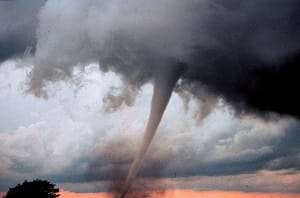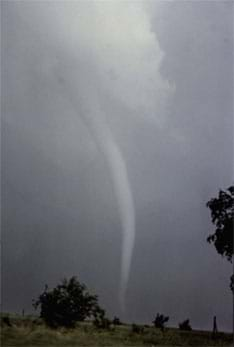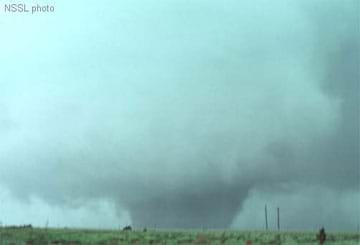Quick Look
Grade Level: 5 (3-5)
Time Required: 45 minutes
Expendable Cost/Group: US $1.00 (unless using a tornado tube, which is approximately $5 for two tubes)
Group Size: 4
Activity Dependency: None
Subject Areas: Earth and Space
NGSS Performance Expectations:

| MS-ESS3-2 |
Summary
In this activity, students learn about how tornadoes are formed and what they look like. By creating a water vortex in a soda bottle, they get a first-hand look at tornadoes.
Engineering Connection
Understanding the science of natural phenomena enables engineers to design and build strong structures. To build homes, schools and bridges that can withstand high wind forces, engineers creatively measure and study tornado characteristics, such as vortex velocity and diameter. Although the variation in tornadoes makes them very difficult to study, engineers continually improve the technology used to measure tornadoes so they better understand how they form, behave and travel.
Learning Objectives
After this activity, students should be able to:
- Understand the properties of tornadoes.
- Understand how tornadoes form a funnel shaped mass of air.
- Understand that engineers design and build structures to withstand tornado damage.
Educational Standards
Each TeachEngineering lesson or activity is correlated to one or more K-12 science,
technology, engineering or math (STEM) educational standards.
All 100,000+ K-12 STEM standards covered in TeachEngineering are collected, maintained and packaged by the Achievement Standards Network (ASN),
a project of D2L (www.achievementstandards.org).
In the ASN, standards are hierarchically structured: first by source; e.g., by state; within source by type; e.g., science or mathematics;
within type by subtype, then by grade, etc.
Each TeachEngineering lesson or activity is correlated to one or more K-12 science, technology, engineering or math (STEM) educational standards.
All 100,000+ K-12 STEM standards covered in TeachEngineering are collected, maintained and packaged by the Achievement Standards Network (ASN), a project of D2L (www.achievementstandards.org).
In the ASN, standards are hierarchically structured: first by source; e.g., by state; within source by type; e.g., science or mathematics; within type by subtype, then by grade, etc.
NGSS: Next Generation Science Standards - Science
| NGSS Performance Expectation | ||
|---|---|---|
|
MS-ESS3-2. Analyze and interpret data on natural hazards to forecast future catastrophic events and inform the development of technologies to mitigate their effects. (Grades 6 - 8) Do you agree with this alignment? |
||
| Click to view other curriculum aligned to this Performance Expectation | ||
| This activity focuses on the following Three Dimensional Learning aspects of NGSS: | ||
| Science & Engineering Practices | Disciplinary Core Ideas | Crosscutting Concepts |
| Construct an oral and written argument supported by empirical evidence and scientific reasoning to support or refute an explanation or a model for a phenomenon or a solution to a problem. Alignment agreement: | Mapping the history of natural hazards in a region, combined with an understanding of related geologic forces can help forecast the locations and likelihoods of future events. Alignment agreement: | The uses of technologies and any limitations on their use are driven by individual or societal needs, desires, and values; by the findings of scientific research; and by differences in such factors as climate, natural resources, and economic conditions. Thus technology use varies from region to region and over time. Alignment agreement: |
International Technology and Engineering Educators Association - Technology
-
Structures need to be maintained.
(Grades
3 -
5)
More Details
Do you agree with this alignment?
State Standards
Colorado - Science
-
Analyze and interpret data identifying ways Earth's surface is constantly changing through a variety of processes and forces such as plate tectonics, erosion, deposition, solar influences, climate, and human activity
(Grade
5)
More Details
Do you agree with this alignment?
-
Develop and communicate an evidence based scientific explanation around one or more factors that change Earth's surface
(Grade
5)
More Details
Do you agree with this alignment?
Materials List
Each group should have:
- Two 2-liter soda bottles (have each student bring one in a week before)
- 2 liters of water
- Duct tape or a tornado tube available from Edmund Scientific Co. (https://www.scientificsonline.com/)
- Copy of Windstorm Journal Page
Worksheets and Attachments
Visit [www.teachengineering.org/activities/view/cub_natdis_lesson08_activity1] to print or download.Introduction/Motivation
Tornados can produce winds up to and over 250 mph. In rare circumstances, tornadoes winds have been measured up to 379 mph. According to NOAA, about 1,000 tornadoes are reported across the United States in an average year, resulting in 80 deaths and over 1,500 injuries.
Tornados are a violently rotating column of wind that can pick up cars and propel them like missiles. They can lift off roofs or even move houses right off their foundation. Tornadoes are usually produced from thunderstorm storms and can cause a damage path greater than one mile wide and up to 50 miles long. Tornados occur at different times in different locations. Peak tornado season in the southern states occurs during March through May. Whereas in the northern states, the peak tornado season occurs from July to August. There is little known information about how tornadoes form. We do know, however, that tornadoes are normally associated with severe thunderstorms and that unstable air aids in their strength.
Tornados can occur at anytime, but most of them have been spotted in the afternoon and evening hours, because the air is hottest in the afternoon and therefore has the greatest tendency to rise. They also can travel in any direction, but according to NOAA, most tornados move from southwest to northeast, or west to east. Not all tornadoes follow these rules and some change direction, or even backtrack. The length of time that tornadoes last varies from a few seconds to more than an hour but most last less than 10 minutes. Because of all the variation in tornadoes, tornadoes are very difficult to study, and as a result, we know little about them.
There are two main types of tornados: rope (see Figure 2) and wedge (see Figure 3). Rope tornadoes are very long and narrow, and wedge tornadoes are huge and wide. Rope tornadoes can produce stronger winds than wedge tornadoes, and vise versa. Size does not mean strength!


Tornadoes occur with the most intensity in the United States in a region called Tornado Alley, which consists of the following states: Alabama, Arkansas, Florida, Georgia, Illinois, Indiana, Iowa, Kansas, Louisiana, Mississippi, Missouri, Nebraska, Oklahoma, South Dakota and Texas.
Today we are going to look at a tornado in a bottle to model the spinning vortex of an actual tornado. This is information that engineers need to understand to be able to predict the damage of tornadoes and how to build structures to keep people safe from the ferocious spinning winds generated by tornadoes.
Procedure
Before the Activity
- Go to the library and check out books on tornados.
- Gather all activity materials.
- Make copies of the Windstorm Journal Page, one for each student.
With the Students
- Discuss with students how tornadoes form and the difference between a wedge and a rope tornado. Show students pictures of tornadoes. Point out the vortex (center) of the tornado. Explain that the strength of the tornado does not depend on its size.
- Have the students fill out the "Vocabulary" section of their Windstorm Journal Page with the following vocabulary words: tornado, vortex, wedge tornado and rope tornado. Have the students define these terms on their own or define together as a class.
- Have the students get into groups of four.
- Instruct students to record observations in their journal. Explain that observations are anything that stands out as important during the activity.
- Fill one of the two-liter bottles with water and connect it to the neck of other bottle with duct tape or a tornado tube.
- Have the students turn the bottles upside down (with the one filled with water on top) and quickly twist them. A tornado vortex will form in the upper bottle.
- Have the students fill out the rest of their journal, and draw pictures of what they saw in the bottle.
- Engineers need to know how tornadoes form and travel in order to help protect people from them. Have the students create an informative flyer about tornadoes by drawing a picture of the spinning vortex of a tornado on a piece of paper. Next to or around the drawing, have students list some facts about tornadoes or things that they have learned about tornadoes. Display these flyers around the classroom or in the hallways to help other students learn about tornadoes.
Vocabulary/Definitions
Rope Tornado: According to NOAA, tornadoes often assume a ropy, sinuous shape in their final minutes; but they can remain narrow like this during their entire life cycles.
tornado: A rotating column of air ranging in width from a few yards to more than a mile and whirling at destructively high speeds, usually accompanied by a funnel-shaped downward extension of a cumulonimbus cloud.
Tornado Alley: A region located in the United States, east of the Rocky Mountains.
vortex: A whirling mass of water or air that sucks everything near it, towards its center.
wedge tornado: A tornado that looks wider than the distance from the ground to cloud base.
Assessment
Pre-Activity Assessment
Discussion: Discuss how tornadoes form and the difference between a wedge and a rope tornado. Show pictures of tornadoes. Point out the vortex (center) of the tornado. Explain that the strength of the tornado does not depend on its size.
Journal/Vocabulary: Using the Windstorm Journal Page (attached), have students fill out the "Vocabulary" section with the following vocabulary words: tornado, vortex, wedge tornado and rope tornado. Have the students define these terms on their own or define together as a class.
Activity Embedded Assessment
Journal: Ask students to record their observations in the "What I've Observed" column on their journal page. Tell students that good scientists record their observations and that an observation is anything that stands out as important during the activity.
Post-Activity Assessment
Journal: Ask students to write down what they have learned under the "What I've Learned" column of the journal. Also, ask them to record any additional questions they might have under that column. Verbally go over what students have learned and record on the board. Then ask for one or two additional questions.
Informative Flyer: Engineers need to know how tornadoes form and travel in order to help protect people from them. Have the students create an informative flyer about tornadoes by drawing a picture of the spinning vortex of a tornado on a piece of paper. Next to or around the drawing, have student list some facts about tornadoes or things that they have learned about tornadoes. Display these flyers around the classroom or in the hallways to help other students learn about tornadoes.
Troubleshooting Tips
Make sure to check seals on bottles. There is the potential for a big water mess if they twist the bottles before they are completely sealed with duct tape.
Activity Extensions
Forecast future tornadoes!
- Instruct students to go NOAA's National Centers For Environmental Information: https://www.ncdc.noaa.gov/climate-information/extreme-events/us-tornado-climatology and complete the Forecast Future Tornadoes! worksheet.
- This worksheet takes students through looking at real data on tornado activity and predicting the likelihood of tornados in certain regions, at different times of the year and during different times of the day.
Research hurricanes and see how they compare to tornados.
Create a smaller vortex using a medium-sized jar:
- Fill the jar three-quarters full with water and add: one teaspoon of liquid dishwashing detergent, one teaspoon of vinegar and/or food coloring of students' choice. Then, tighten the lid and shake the jar in a circular manner. A vortex will form and be clearly visible.
Places to find further information about Tornados:
Subscribe
Get the inside scoop on all things TeachEngineering such as new site features, curriculum updates, video releases, and more by signing up for our newsletter!More Curriculum Like This

Students learn about tornadoes - their basic characteristics, damage and occurrence. Students are introduced to the ways that engineers consider strong winds, specifically tornadoes, in their design of structures.

In this activity, students learn about how tornadoes are formed and what they look like. By creating a water vortex in a soda bottle, they get a first-hand look at tornadoes.
References
http://www.noaa.gov/tornadoes.html
http://www.asce.org/pressroom/publicpolicy/ka0100_windhazard.cfm
http://www.nssl.noaa.gov/
http://www.noaa.gov/tornadoes.html
Copyright
© 2004 by Regents of the University of Colorado.Contributors
Jessica Todd; Melissa Straten; Malinda Schaefer Zarske; Janet YowellSupporting Program
Integrated Teaching and Learning Program, College of Engineering, University of Colorado BoulderAcknowledgements
The contents of this digital library curriculum were developed under a grant from the Fund for the Improvement of Postsecondary Education (FIPSE), U.S. Department of Education, and National Science Foundation GK-12 grant no 0338326. However, these contents do not necessarily represent the policies of the Department of Education or National Science Foundation, and you should not assume endorsement by the federal government.
Last modified: June 2, 2022








User Comments & Tips